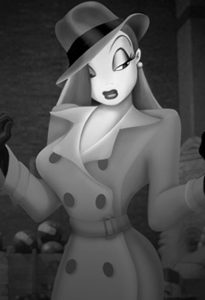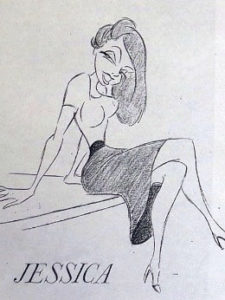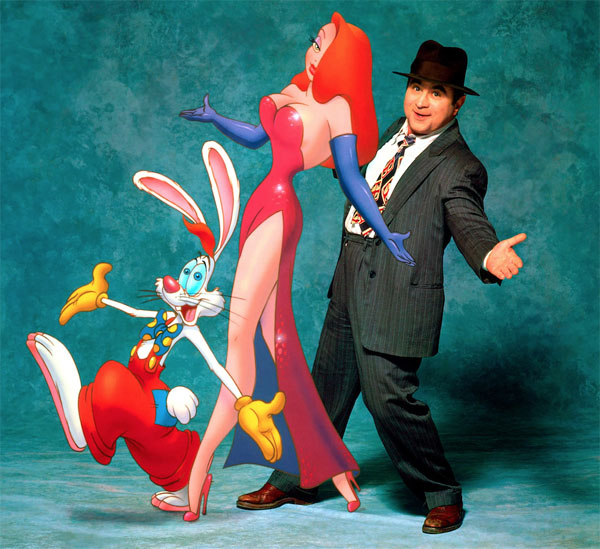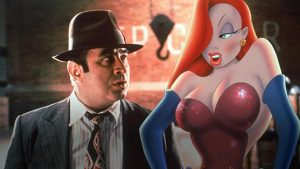Suspended Animation #363
 Disneyland’s Car Toon Spin attraction that opened in 1994 recently underwent an overhaul of the character of Jessica Rabbit. In the ride, guests board Lenny the Cab (Benny’s cousin) in a race through Toontown to try to rescue Jessica who has been kidnapped by the weasels.
Disneyland’s Car Toon Spin attraction that opened in 1994 recently underwent an overhaul of the character of Jessica Rabbit. In the ride, guests board Lenny the Cab (Benny’s cousin) in a race through Toontown to try to rescue Jessica who has been kidnapped by the weasels.
Actually, Jessica rescues herself by hitting the weasels on the head with a giant mallet. However, Disney was uncomfortable with portraying her as a victim so now she is a detective on the hunt for the bad weasels and dressed in a long trench coat that hides her cleavage and most of her bare legs.
CEO Michael Eisner considered Who Framed Roger Rabbit (1988) too risque, especially the scenes with Jessica, which is just one of the reasons why the movie was originally released under the Touchstone Pictures label rather than the Disney banner. It became so popular that like Touchstone’s The Nightmare Before Christmas (1993), it is now officially considered a Disney film.
“I’m not bad. I’m just drawn that way,” affirmed Jessica Rabbit in her alluringly hoarse whisper of a voice. While Disney female characters from Tinker Bell to Ariel to Slue Foot Sue to some others have always embodied a sort of healthy but innocent sexiness, Jessica Rabbit was the first Disney cartoon character to be blatantly sexual in nature.
 In the original 1981 novel Who Censored Roger Rabbit? written by Gary Wolf, Jessica is a much more devious and jaded character and not above using her sexual endowments to get what she wants. In fact, in her younger days she even appeared in a Tijuana Bible, a plot point in the novel.
In the original 1981 novel Who Censored Roger Rabbit? written by Gary Wolf, Jessica is a much more devious and jaded character and not above using her sexual endowments to get what she wants. In fact, in her younger days she even appeared in a Tijuana Bible, a plot point in the novel.
The harsher character description from the book influenced director Darrell Van Citters and designer Mike Giaimo when they tackled the first animated attempt of the character to look more like a young Lauren Bacall in a film noir, very slender with high cheekbones and flowing hair.
“We started with a Jessica that was much more illustrative, but one day one of the writers came to me and said I should make her more ‘cartoony’. So I did,” recalled supervising animation director Richard Williams of the later attempt at the character.
“I used a combination of Veronica Lake, Rita Hayworth and Sophia Loren. It’s so funny that she’s become this pin-up. Of course, she’s absurd. Her waist is so tiny that she’d fall over if she was real.”
The famous peek-a-boo hair style of Veronica Lake, the distinctive, seductive red hair of Rita Hayworth and the voluptuous physique of Sophia Loren combined with their screen personas of being the most desirable women in the world were the physical foundation for Williams’ interpretation of Jessica.

Jessica’s waist was made incredibly tiny not just for cartoon exaggeration, but to convince audiences that the character was not simply rotoscoped (traced from live action) but drawn.
“When we were filming, nobody really knew what the final Jessica Rabbit looked like,” explained actor Bob Hoskins who played detective Eddie Valiant. “Zemeckis said, ‘Think of the sexiest woman you can imagine, Bob. Think of sex!’ I thought up this really sexy bird, thinking, ‘Ooooh, wonderful.’
“They did the work on Jessica up in Camden Town, and I used to live round there, so they’d call and say, ‘Come and see what we’re doing.’ When I saw it, she was just so sexy that I felt so boring. The bird I’d created was like some person’s old granny compared to this.”
 “She had to be a testament to what a man could do with a pencil and a fertile imagination,” remarked supervising animator Russell Hall. “In a sense, she shares the two realities of the cartoon world and the real world. She would have to appeal to both the rabbit and Bob Hoskins.”
“She had to be a testament to what a man could do with a pencil and a fertile imagination,” remarked supervising animator Russell Hall. “In a sense, she shares the two realities of the cartoon world and the real world. She would have to appeal to both the rabbit and Bob Hoskins.”
When Disney MGM Studios opened in May 1989, theme park guests who disembarked from the Backlot Tram Tour found themselves in a merchandise venue called “The Loony Bin” themed to Who Framed Roger Rabbit.
Guests had two opportunities to pose with Jessica. There was a glittery life-sized plywood cutout of the character for amateur photographers. In addition, the photo shop allowed guests to don Eddie Valiant’s overcoat and hat and be superimposed into an actual cartoon drawing with Jessica.
At the time, the Disney Company was uncomfortably unfamiliar with how to deal with such a flamboyantly sexual character. Jessica was a troubling anomaly who wasn’t able to be shoehorned into the familiar Disney brand. Storybooks and coloring books presented Jessica in a modified dress that was less revealing.
 Frustrating to the Disney Company was its inability to completely control Jessica’s sexual image being used in the general public.
Frustrating to the Disney Company was its inability to completely control Jessica’s sexual image being used in the general public.
The cover of the November 1988 issue of Playboy featured an airbrushed photo of September Playmate Laura Richmond portraying Jessica Rabbit. Disney tried to ignore it but was less cavalier when the French edition of the July 1989 issue of Penthouse magazine was released.
Reportedly at that time, Disney had not yet secured the international copyright for the character. An oversight quickly corrected when the company saw the magazine issue featuring a cel-like drawing of a topless Jessica with long purple gloves, purple garter belt and purple bikini panties and the interior mixed with art from the film and naked poses of Jessica.
When the film was first released, no mention was made that the real voice of Jessica was supplied by the breathy delivery of actress Kathleen Turner with Steven Spielberg’s ex-wife Amy Irving doing the singing voice.
Turner recalled, “It was perfect for me at the time because I was pregnant. I could just waddle into the studio and off I’d go. We had a lot of fun in terms of Jessica’s breathing. I said, ‘She’s got such big boobs, so why don’t we add in lots of sighs, and then you guys can make them bounce?'”

Jessica’s “body performance model” was actress Betsy Brantley. Brantley was in her early 30s when she went through the movement for the character like walking down the stage in the Ink and Paint Club. The painted image of Jessica was superimposed over Brantley’s movement just like a painted image of Benny the Cab was superimposed over the mechanics of the vehicle that drove down the streets.
Brantley played the role of the mother of the boy who is listening to his grandfather tell him a story in The Princess Bride (1987) around the same time period.
Costume Designer Joanna Johnston in Entertainment Weekly magazine from February 15, 2013 who designed costumes for both live and animated characters in the film (1988) stated: “It was too expensive to animate Jessica Rabbit in sequins for the whole movie. The compromise was that she wear sequins on stage and satin the rest of the time. At my young age, I was really upset that she wasn’t going to be in sequins all the way through.”
The Disney Jessica later appeared briefly in three theatrical cartoon shorts: Tummy Trouble (1989), Roller Coaster Rabbit (1990) and Trail Mix Up (1993). A fourth cartoon short, Hare in My Soup, was planned but never made. For decades there have been several attempts to make a prequel to the original feature film.


 Jim Korkis is an internationally respected animation historian who in recent years has devoted his attention to the many worlds of Disney. He was a columnist for a variety of animation magazines. With his former writing partner, John Cawley, he authored several animation related books including The Encyclopedia of Cartoon Superstars, How to Create Animation, Cartoon Confidential and Get Animated’s Animation Art Buyer’s Guide. He taught animation classes at the Disney Institute in Florida as well as instructing classes on acting and animation history for Disney Feature Animation: Florida.
Jim Korkis is an internationally respected animation historian who in recent years has devoted his attention to the many worlds of Disney. He was a columnist for a variety of animation magazines. With his former writing partner, John Cawley, he authored several animation related books including The Encyclopedia of Cartoon Superstars, How to Create Animation, Cartoon Confidential and Get Animated’s Animation Art Buyer’s Guide. He taught animation classes at the Disney Institute in Florida as well as instructing classes on acting and animation history for Disney Feature Animation: Florida.




















































I love Jessica Rabbit as a character, but sometimes I feel like I’m the only cartoon fanatic who feels she’s too exaggerated to be sexy. Preston Blair’s Red is, to me, a lot more attractive.
Ah, Jessica — along with the opening cartoon “Somethin’s Cookin'”, one of the best things about “Who Framed Roger Rabbit”, good enough to make its flaws forgivable. Any detective story set in the 1940s has got to have a sexy dame if it’s going to be true to the genre; and if the story is set in a cartoon world, such a character will perforce owe as much to Tex Avery’s Red, and the sexy girls in Walter Lantz’s Swing Symphonies, as to the pinup stars of that decade. In both design and execution, Jessica Rabbit was perfect in the role. Three cheers to everyone who drew her “that way.”
It’s funny how some people will obsess over the narrow waists of some female cartoon characters. When I saw “Sleeping Beauty” around 1980, every time Princess Aurora came on screen my girlfriend elbowed me in the ribs and whispered “Look at that waist! Look at that waist!” An awful lot of parental commentary about Winx Club suggests that it’s a show about six impossibly slender fairies on a mission to give every single girl in the world an eating disorder. Maybe there’s something wrong with me, but I can enjoy a cartoon without dwelling on the notion that any woman who wanted a figure like Aurora or Bloom or Jessica in real life would have to have four ribs and a metre of small bowel surgically removed, or that Charlie Brown would have to wear a neck brace to keep his monstrously swollen head from crushing his cervical vertebrae. What’s the point? I’d rather focus on the story.
This post reminds me that in 1988, I went to over a dozen bookstores in three different states on a quest for Gary K. Wolf’s novel “Who Censored Roger Rabbit?” — all to no avail. Not one of them had it in stock. I still find this puzzling: you’d think that a book that was the basis for the number one movie of the year would be easier to find. Did Disney, Spielberg etc. have some kind of arrangement to keep the book out of circulation during the film’s release?
Huh. The crappy B.Dalton in my podunk hometown had plenty of the paperbacks. And prominently displayed, too.
I found a used copy of the book through, I think, iLibris. You didn’t miss a thing; it’s all but unreadable, and has almost nothing to do with the movie.
There was a store with a gigantic Jessica in the old Pleasure Island complex in Orlando Florida.Her leg would swing sexily back and forth.It was later replaced by a cigar bar.I wonder what became of her?
Faintly recall reading that Disney made a point of not selling or tossing that particular sign because they didn’t want to risk it ending up in front of a strip club or some other unsavory locale.
Thing about Jessica Rabbit is that she’s not so much sexy as a caricature of sexy, the way late-period Bluto is a caricature of physical strength.
There’s a Woody Woodpecker cartoon where Woody in drag vamps a western bandit. He briefly hikes up his skirt to reveal a pair of shapely mannequin legs. The bandit reacts. Woody repeats, now displaying FOUR shapely legs. The bandit finds this even more exciting. Finally Woody unveils a dozen shapely legs for a one-Woodpecker kick line. The bandit goes full Tex Avery.
Jessica was created on the same principle, combining a bunch of pop symbols of sexiness into one impossible whole. We accept her as being outrageously sexy instead of simply outrageous within the film, thanks to inspired execution and reactions of other characters.
Robert Zemeckis mentioned in a interview with Slashfilm that Jessica was one of the reasons why Disney today isn’t all too interested in reviving Roger Rabbit for any new sequel.
I animated the close-up shot of Jessica in “Trail Mix-up”, Mark Henn animated just about all the rest of her scenes. Her breasts were front and center in my scene, of course, and they led the rest of her body as she leaned over Roger. Of course, this led to OUTRAGED EXECUTIVE MEETINGS, in which a size guide was issued for “Jessica’s Breast Reduction”, as they called it. Well, they are reduced at the start of the shot, but towards the middle, they get back to their “real” size. I also animated Droopy in the cartoon, as well as working on story. Pat Ventura was really the spark plug on story, he did the entire cartoon’s story board. Barry Cook was the director, and was a lot of fun to work with. I animated in Glendale, and the rest was done at the (now closed) Disney/MGM animation studio in Orlando. At one time, there were TWELVE Roger Rabbit shorts in development hell at Disney. “Hare In My Soup” started as a simple story about Roger as a waiter in a restaurant, then got sidetracked in to another “Baby Herman in Peril” story line. They must have boarded that short 30 times, under many different teams, they finally gave up on it. Bill Kopp wrote a hilarious Roger story in which Roger gets hit on the head one too many times, and reverts to a baby personality. Baby Herman now has to take care of “Baby” Roger! The funniest scene was an X-Ray view of Roger’s skull, as the doctors said, “One more Hit, and his cheese is going to slip off his cracker.” The X-Ray showed a literal view of a big hunk of cheddar precariously balanced on a soda cracker over a pool of acid in Roger’s brain. They turned that one down too. Roger had so much potential as a fun and funny cartoon character, but he got caught in a web of corporate fights between Disney and Spielberg and sourpusses who just didn’t like cartoon humor.
Thank you for sharing. What a shame there was so much meddling and the other shorts never made it to fruition. I’d especially loved to have seen that ‘Baby Roger’ cartoon! People forget nowadays just how hugely popular the Roger Rabbit characters were in the early 90’s and I, for one, was eager for more. I watched the three shorts so many times and always appreciated the frantic energy, smooth animation, gags and hidden details. Again, I so wish we’d gotten more – sounds like they’d have been a blast!
I still find it hard to believe that nobody saw Kinney’s DUCK PIMPLES (1945), with its very Jessica-like Pauline (right down to the red hair and violet dress) and not get some inspiration from that.
Maybe because Pauline isn’t very sexy. Her movements are jerky and rubbery, her skin deathly white; and she makes no effort to entice Donald, Hennessy, or any of the other characters.
But then Jessica really was meant to be a parody of her type, the same way that Roger was supposed to represent a typical 1940s screwball cartoon animal character. Which is why they didn’t last, even though they still inspire Halloween costumes (and some deranged women actually have had plastic surgery to look like Jessica, with predictably unhappy results).
Jessica’s buxom, tiny waisted figure was probably inspired by Jayne Mansfield (as well as Sophia Loren, Marilyn Monroe and Jane Russell). She starred in a few films directed by Frank Tashlin most notably The Girl Can’t Help It. In a nightclub scene Mansfield wears a red sequined dress that bears an uncanny resemblance to the one Jessica wears at the Ink and Paint Club.
Overall, I think Who Framed Roger Rabbit is more of a Warner Bros or MGM cartoon than a Disney. And that’s kinda the problem. Warner Bros. wouldn’t bat an eye over how Jessica looks. But Disney, every other day they are having “problems”, as they try to deny the existent of sex.
That said, Jessica never bother me and my cartoon friends- she was a cartoon character, like Tex’s Red. But when we saw Helga Katrina in Atlantis: The Lost Empire. That was a holy cr@p moment. As that, was a character we never thought we’d see in a Disney animated movie! I guess Disney was lucky that it wasn’t a big hit. Or they would have to deal with her year-in and year-out.